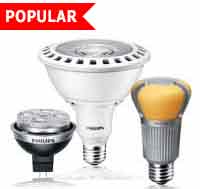New Lighting Facts Label: Takes the Guess Work Out of Shopping for Light Bulbs
If you're like me, it sometimes feels overwhelming standing at the store and staring at a big wall of light bulbs, trying to understand all the lighting choices. With new lighting standards taking effect this year, now's a great time switch to energy-saving incandescent, CFL, and LED light bulbs, which are available in most hardware and home improvement retailers. They all are more energy-efficient than traditional incandescent bulbs, and upgrading 15 of the inefficient incandescent light bulbs in your home could save you about $50 per year.I've learned that when I'm shopping for light bulbs, it's most important to compare lumens to be sure I'm getting the amount of light, or level of brightness, I want. More lumens means it's a brighter light; fewer lumens means it's a dimmer light.
The brightness, or lumen levels, of the lights in your home may vary widely, so here's a rule of thumb:
- To replace a 100-watt (W) incandescent bulb, look for a bulb that gives you about 1600 lumens. If you want something dimmer, go for less lumens; if you prefer brighter light, look for more lumens.
- Replace a 75 W bulb with an energy-saving bulb that gives you about 1100 lumens.
- Replace a 60 W bulb with an energy-saving bulb that gives you about 800 lumens.
- Replace a 40 W bulb with an energy-saving bulb that gives you about 450 lumens.
To help people like you and me better understand the switch from watts to lumens, the Federal Trade Commission will require a new product label for light bulbs in the coming months. It will help people buy the light bulbs that are right for them.
The Lighting Facts label will help consumers understand what they are really purchasing. The label clearly provides the lumens—or brightness—of the bulb, the estimated operating cost for the year, and the color of the light (from warm/yellowish, to white to cool/blue).
Source: ECN

















Comments